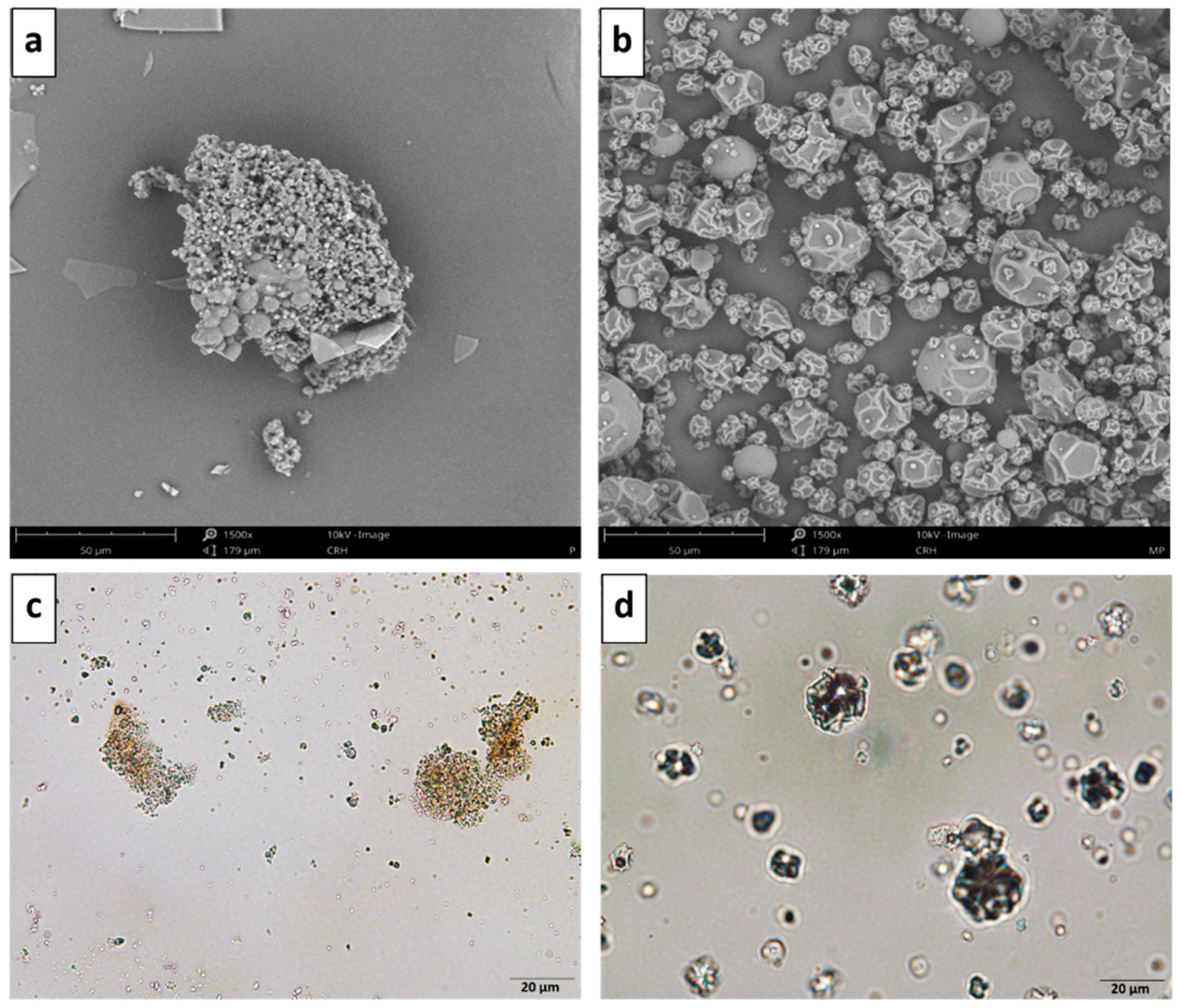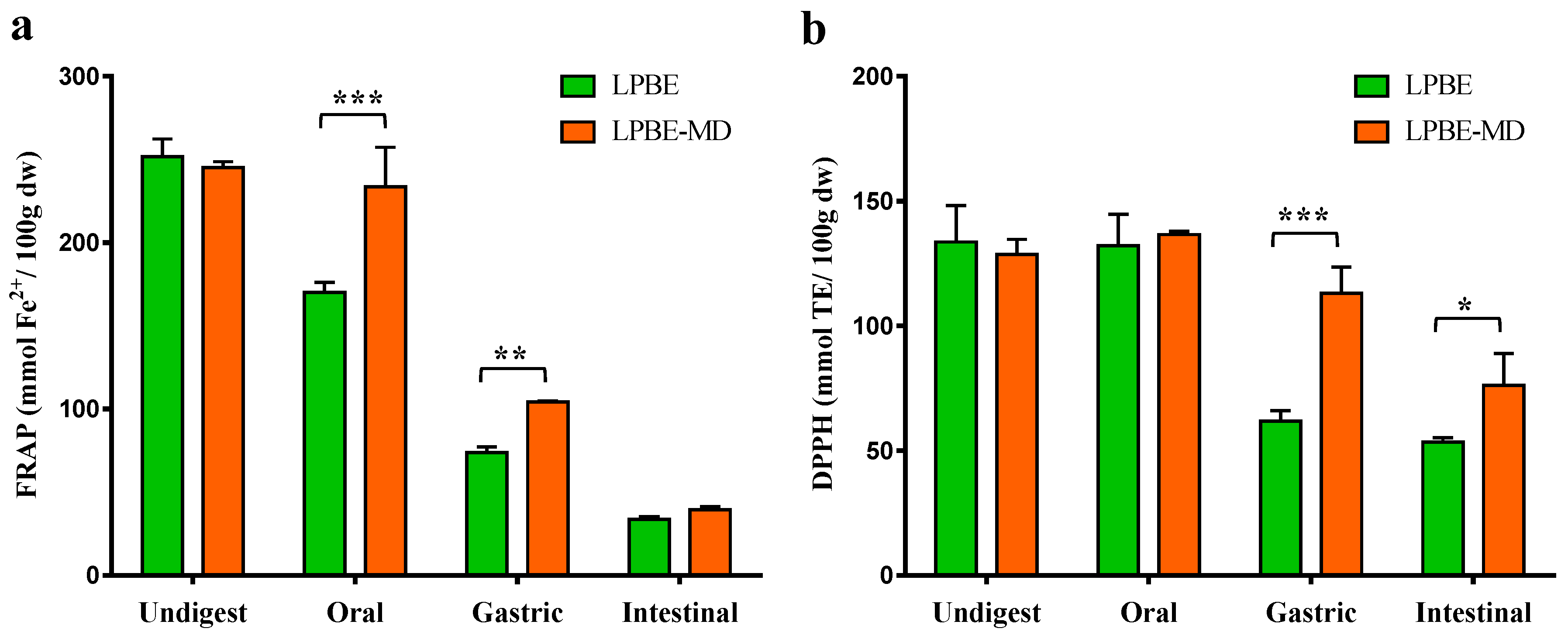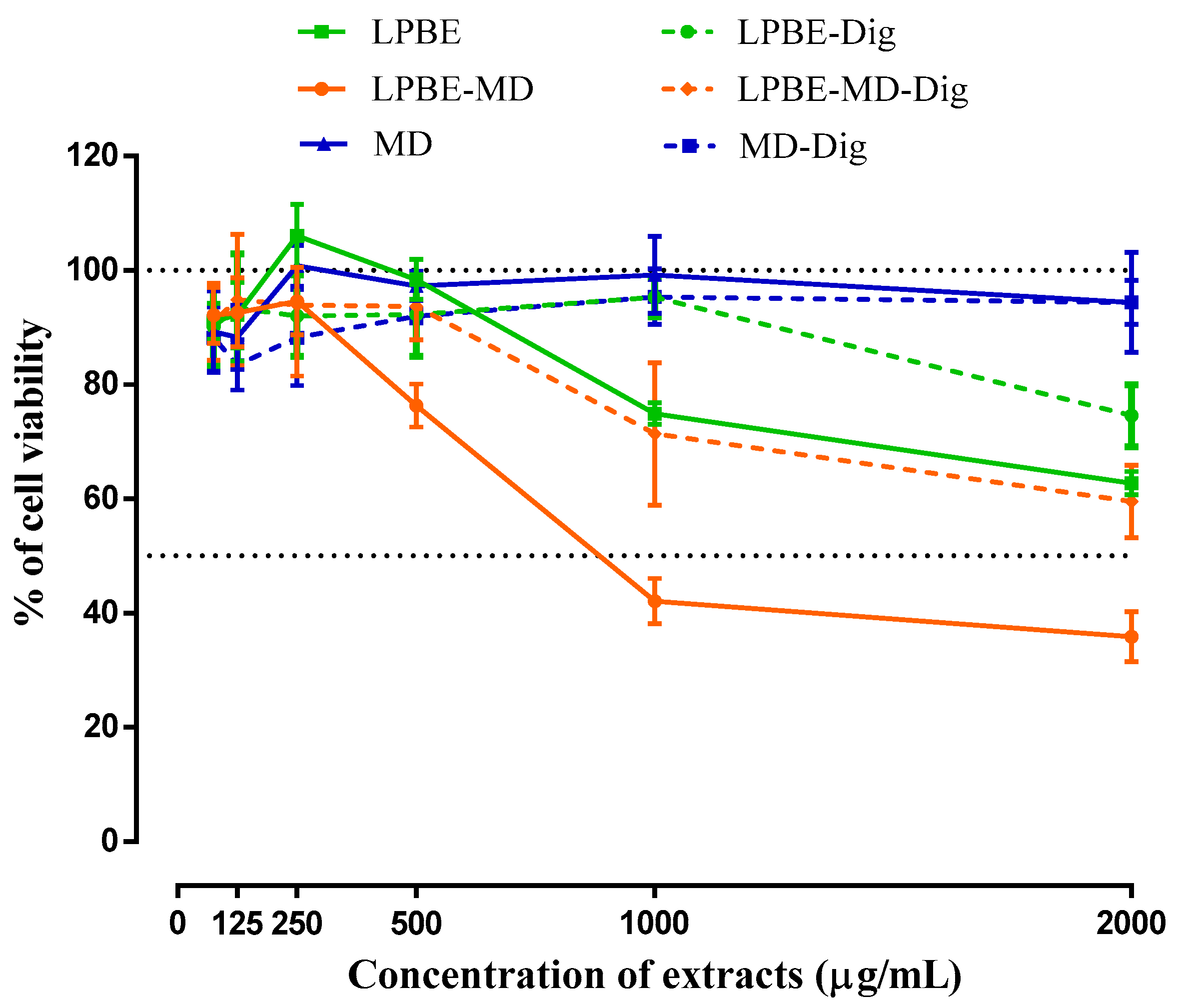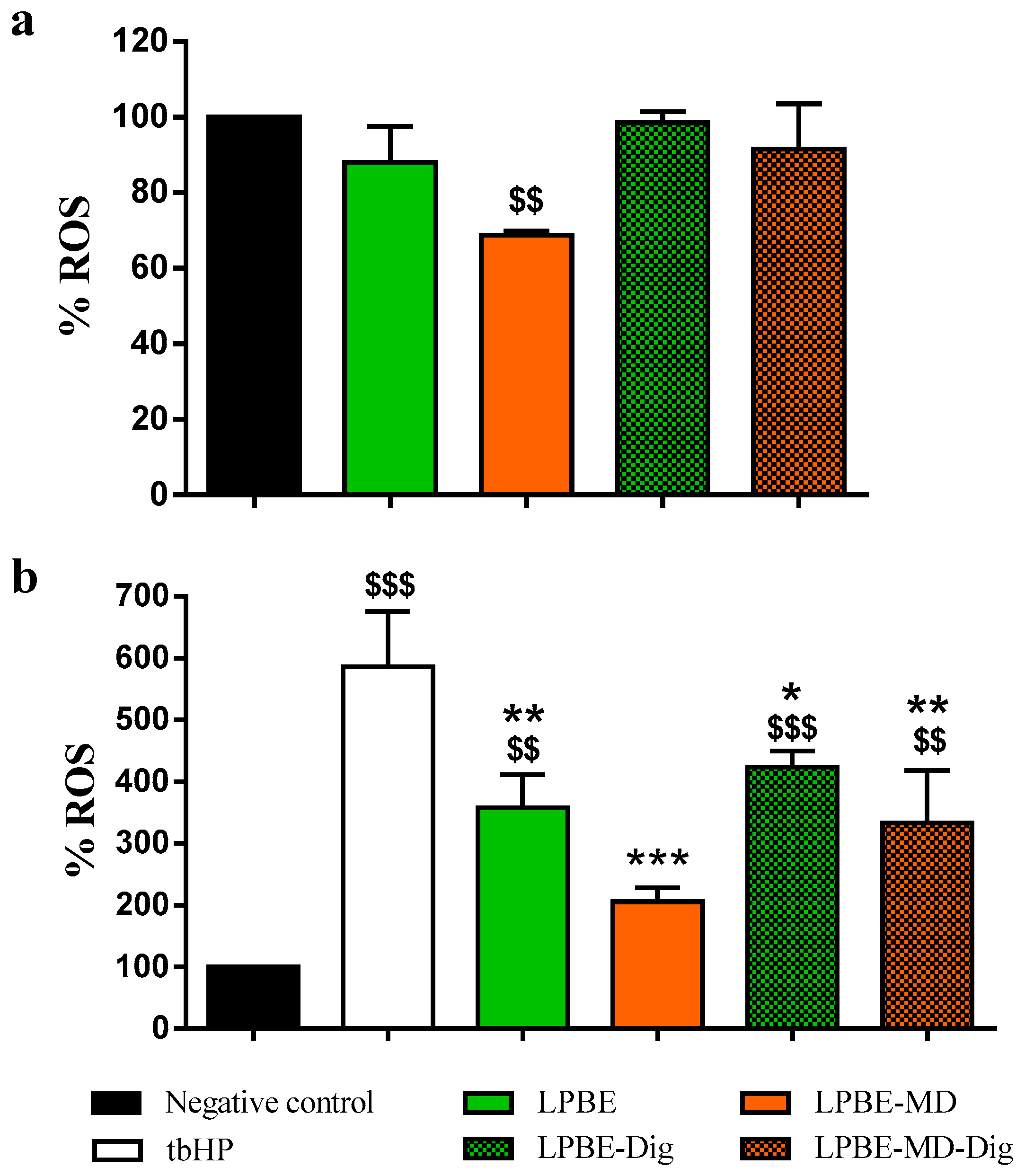Encapsulated Pine Bark Polyphenolic Extract during Gastrointestinal Digestion: Bioaccessibility, Bioactivity and Oxidative Stress Prevention
Abstract
1. Introduction
2. Materials and Methods
2.1. Raw Material and Chemicals
2.2. Pine Bark Extract Preparation
2.3. Encapsulation Process by Spray-Drying
2.3.1. Experimental Design
2.3.2. Optimization by RSM
2.4. Moisture Content
2.5. Soluble Solids Content
2.6. Encapsulation Efficiency for TPC and AA
2.7. Structural Characterization
2.8. Encapsulated Extract Analysis
2.8.1. Total Phenolic Content (TPC)
2.8.2. Antioxidant Activity (AA)
2.8.3. Antimicrobial Activity
2.9. In Vitro Gastrointestinal Digestion
2.10. Bioaccessibility of Phenolic Compounds
2.11. Individual Phenolic Compounds Determination and Quantification by UHPLC
2.12. Biological Assays
2.12.1. Cell Viability
2.12.2. Measurement of Intracellular ROS Levels
2.13. Statistical Analysis
3. Results and Discussion
3.1. Spray-Drying Process Evaluation
3.1.1. Moisture Content and Encapsulation Efficiency
3.1.2. Optimal Encapsulation Conditions and Model Validation
3.2. Structural Characterization
3.3. Antimicrobial Activity Evaluation
3.4. Effect of Simulated In Vitro Gid on Pine Bark Extracts
3.4.1. Phenolic Compounds Determination and Bioaccessibility Analysis
3.4.2. Antioxidant Activity
3.4.3. Cellular Viability and Antioxidant Capacity on Intestinal Caco-2 Cells
4. Conclusions
Supplementary Materials
Author Contributions
Funding
Data Availability Statement
Conflicts of Interest
References
- Mannino, G.; Di Stefano, V.; Lauria, A.; Pitonzo, R.; Gentile, C. Vaccinium macrocarpon (Cranberry)-Based Dietary Supplements: Variation in Mass Uniformity, Proanthocyanidin Dosage and Anthocyanin Profile Demonstrates Quality Control Standard Needed. Nutrients 2020, 12, 992. [Google Scholar] [CrossRef] [PubMed]
- Hamulka, J.; Jeruszka-Bielak, M.; Górnicka, M.; Drywień, M.E.; Zielinska-Pukos, M.A. Dietary Supplements during COVID-19 Outbreak. Results of Google Trends Analysis Supported by PLifeCOVID-19 Online Studies. Nutrients 2020, 13, 54. [Google Scholar] [CrossRef]
- Ferreira-Santos, P.; Genisheva, Z.; Pereira, R.N.; Teixeira, J.A.; Rocha, C.M.R. Moderate Electric Fields as a Potential Tool for Sustainable Recovery of Phenolic Compounds from Pinus pinaster Bark. ACS Sustain. Chem. Eng. 2019, 7, 8816–8826. [Google Scholar] [CrossRef]
- Mármol, I.; Quero, J.; Jiménez-Moreno, N.; Rodríguez-Yoldi, M.J.; Ancín-Azpilicueta, C. A systematic review of the potential uses of pine bark in food industry and health care. Trends Food Sci. Technol. 2019, 88, 558–566. [Google Scholar] [CrossRef]
- Tümen, İ.; Akkol, E.K.; Taştan, H.; Süntar, I.; Kurtca, M. Research on the antioxidant, wound healing, and anti-inflammatory activities and the phytochemical composition of maritime pine (Pinus pinaster Ait). J. Ethnopharmacol. 2018, 211, 235–246. [Google Scholar] [CrossRef]
- Grether-Beck, S.; Marini, A.; Jaenicke, T.; Krutmann, J. French Maritime Pine Bark Extract (Pycnogenol®) Effects on Human Skin: Clinical and Molecular Evidence. Skin Pharmacol. Physiol. 2016, 29, 13–17. [Google Scholar] [CrossRef] [PubMed]
- Rohdewald, P. A review of the French maritime pine bark extract (Pycnogenol), a herbal medication with a diverse clinical pharmacology. Int. J. Clin. Pharmacol. Ther. 2002, 40, 158–168. [Google Scholar] [CrossRef]
- Jiménez-Moreno, N.; Cimminelli, M.J.; Volpe, F.; Ansó, R.; Esparza, I.; Mármol, I.; Rodríguez-Yoldi, M.J.; Ancín-Azpilicueta, C. Phenolic Composition of Artichoke Waste and its Antioxidant Capacity on Differentiated Caco-2 Cells. Nutrients 2019, 11, 1723. [Google Scholar] [CrossRef] [PubMed]
- Mrduljaš, N.; Krešić, G.; Bilušić, T. Polyphenols: Food Sources and Health Benefits. In Functional Food—Improve Health through Adequate Food; Hueda, M.C., Ed.; IntechOpen: London, UK, 2017. [Google Scholar]
- Gascón, S.; Jiménez-Moreno, N.; Jiménez, S.; Quero, J.; Rodríguez-Yoldi, M.J.; Ancín-Azpilicueta, C. Nutraceutical composition of three pine bark extracts and their antiproliferative effect on Caco-2 cells. J. Funct. Foods 2018, 48, 420–429. [Google Scholar] [CrossRef]
- de Vos, P.; Faas, M.M.; Spasojevic, M.; Sikkema, J. Encapsulation for preservation of functionality and targeted delivery of bioactive food components. Int. Dairy J. 2010, 20, 292–302. [Google Scholar] [CrossRef]
- Brodkorb, A.; Egger, L.; Alminger, M.; Alvito, P.; Assunção, R.; Ballance, S.; Bohn, T.; Bourlieu-Lacanal, C.; Boutrou, R.; Carrière, F.; et al. INFOGEST static in vitro simulation of gastrointestinal food digestion. Nat. Protoc. 2019, 14, 991–1014. [Google Scholar] [CrossRef] [PubMed]
- González, E.; Gómez-Caravaca, A.M.; Giménez, B.; Cebrián, R.; Maqueda, M.; Martínez-Férez, A.; Segura-Carretero, A.; Robert, P. Evolution of the phenolic compounds profile of olive leaf extract encapsulated by spray-drying during in vitro gastrointestinal digestion. Food Chem. 2019, 279, 40–48. [Google Scholar] [CrossRef] [PubMed]
- Wang, L.; Li, X.; Wang, H. Physicochemical properties, bioaccessibility and antioxidant activity of the polyphenols from pine cones of Pinus koraiensis. Int. J. Biol. Macromol. 2019, 126, 385–391. [Google Scholar] [CrossRef] [PubMed]
- Gharsallaoui, A.; Roudaut, G.; Chambin, O.; Voilley, A.; Saurel, R. Applications of spray-drying in microencapsulation of food ingredients: An overview. Food Res. Int. 2007, 40, 1107–1121. [Google Scholar] [CrossRef]
- Desobry, S.A.; Netto, F.; Labuza, T.P. Comparison of Spray-drying, Drum-drying and Freeze-drying for β-Carotene Encapsulation and Preservation. J. Food Sci. 1997, 62, 1158–1162. [Google Scholar] [CrossRef]
- Desai, K.G.H.; Jin Park, H. Recent Developments in Microencapsulation of Food Ingredients. Dry. Technol. 2005, 23, 1361–1394. [Google Scholar] [CrossRef]
- Pourashouri, P.; Shabanpour, B.; Razavi, S.H.; Jafari, S.M.; Shabani, A.; Aubourg, S.P. Oxidative Stability of Spray-Dried Microencapsulated Fish Oils with Different Wall Materials. J. Aquat. Food Prod. Technol. 2014, 23, 567–578. [Google Scholar] [CrossRef]
- Arepally, D.; Goswami, T.K. Effect of inlet air temperature and gum Arabic concentration on encapsulation of probiotics by spray drying. LWT Food Sci. Technol. 2019, 99, 583–593. [Google Scholar] [CrossRef]
- Ballesteros, L.F.; Ramirez, M.J.; Orrego, C.E.; Teixeira, J.A.; Mussatto, S.I. Encapsulation of antioxidant phenolic compounds extracted from spent coffee grounds by freeze-drying and spray-drying using different coating materials. Food Chem. 2017, 237, 623–631. [Google Scholar] [CrossRef]
- Tsali, A.; Goula, A.M. Valorization of grape pomace: Encapsulation and storage stability of its phenolic extract. Powder Technol. 2018, 340, 194–207. [Google Scholar] [CrossRef]
- Ferreira-Santos, P.; Genisheva, Z.; Botelho, C.; Santos, J.; Ramos, C.; Teixeira, J.A.; Rocha, C.M.R. Unravelling the Biological Potential of Pinus pinaster Bark Extracts. Antioxidants 2020, 9, 334. [Google Scholar] [CrossRef]
- Derringer, G.; Suich, R. Simultaneous Optimization of Several Response Variables. J. Qual. Technol. 1980, 12, 214–219. [Google Scholar] [CrossRef]
- Zhang, L.; Taal, M.A.; Boom, R.M.; Chen, X.D.; Schutyser, M.A.I. Effect of baking conditions and storage on the viability of Lactobacillus plantarum supplemented to bread. LWT Food Sci. Technol. 2018, 87, 318–325. [Google Scholar] [CrossRef]
- Tsao, R.; Yang, R.; Young, J.C. Antioxidant Isoflavones in Osage Orange, Maclura pomifera (Raf.) Schneid. J. Agric. Food Chem. 2003, 51, 6445–6451. [Google Scholar] [CrossRef]
- Salvia-Trujillo, L.; Rojas-Graü, M.A.; Soliva-Fortuny, R.; Martín-Belloso, O. Impact of microfluidization or ultrasound processing on the antimicrobial activity against Escherichia coli of lemongrass oil-loaded nanoemulsions. Food Control 2014, 37, 292–297. [Google Scholar] [CrossRef]
- Minekus, M.; Alminger, M.; Alvito, P.; Ballance, S.; Bohn, T.; Bourlieu, C.; Carrière, F.; Boutrou, R.; Corredig, M.; Dupont, D.; et al. A standardised static in vitro digestion method suitable for food-an international consensus. Food Funct. 2014, 5, 1113–1124. [Google Scholar] [CrossRef]
- Busaranon, K.; Suntornsuk, W.; Suntornsuk, L. Comparison of UV spectrophotometric method and high performance liquid chromatography for the analysis of flunarizine and its application for the dissolution test. J. Pharm. Biomed. Anal. 2006, 41, 158–164. [Google Scholar] [CrossRef]
- Nguyen, D.Q.; Nguyen, T.H.; Mounir, S.; Allaf, K. Effect of feed concentration and inlet air temperature on the properties of soymilk powder obtained by spray drying. Dry. Technol. 2018, 36, 817–829. [Google Scholar] [CrossRef]
- Gullón, B.; Montenegro, M.I.; Ruiz-Matute, A.I.; Cardelle-Cobas, A.; Corzo, N.; Pintado, M.E. Synthesis, optimization and structural characterization of a chitosan-glucose derivative obtained by the Maillard reaction. Carbohydr. Polym. 2016, 137, 382–389. [Google Scholar] [CrossRef] [PubMed]
- Zanoni, F.; Primiterra, M.; Angeli, N.; Zoccatelli, G. Microencapsulation by spray-drying of polyphenols extracted from red chicory and red cabbage: Effects on stability and color properties. Food Chem. 2020, 307, 125535. [Google Scholar] [CrossRef]
- Santiago-adame, R.; Medina-torres, L.; Gallegos-infante, J.A.; Calderas, F. Spray drying-microencapsulation of cinnamon infusions ( Cinnamomum zeylanicum ) with maltodextrin. LWT Food Sci. Technol. 2015, 64, 571–577. [Google Scholar] [CrossRef]
- Kotzekidou, P.; Giannakidis, P.; Boulamatsis, A. Antimicrobial activity of some plant extracts and essential oils against foodborne pathogens in vitro and on the fate of inoculated pathogens in chocolate. LWT Food Sci. Technol. 2008, 41, 119–127. [Google Scholar] [CrossRef]
- Oliveira, D.A.; Salvador, A.A.; Smânia, A.; Smânia, E.F.A.; Maraschin, M.; Ferreira, S.R.S. Antimicrobial activity and composition profile of grape (Vitis vinifera) pomace extracts obtained by supercritical fluids. J. Biotechnol. 2013, 164, 423–432. [Google Scholar] [CrossRef] [PubMed]
- Kozłowska, M.; Laudy, E.A.; Przybył, J.; Ziarno, M.; Majewska, E. Chemical composition and antibacterial activity of some medicinal plants from Lamiaceae family. Acta Pol. Pharm. 2015, 72, 757–767. [Google Scholar]
- González-Ballesteros, N.; Rodríguez-Argüelles, M.C.; Prado-López, S.; Lastra, M.; Grimaldi, M.; Cavazza, A.; Nasi, L.; Salviati, G.; Bigi, F. Macroalgae to nanoparticles: Study of Ulva lactuca L. role in biosynthesis of gold and silver nanoparticles and of their cytotoxicity on colon cancer cell lines. Mater. Sci. Eng. C 2019, 97, 498–509. [Google Scholar] [CrossRef]
- Vulić, J.; Šeregelj, V.; Kalušević, A.; Lević, S.; Nedović, V.; Šaponjac, V.T.; Čanadanović-Brunet, J.; Ćetković, G. Bioavailability and bioactivity of encapsulated phenolics and carotenoids isolated from red pepper waste. Molecules 2019, 24, 2837. [Google Scholar] [CrossRef] [PubMed]
- Frontela, C.; Ros, G.; Martínez, C.; Sánchez-Siles, L.M.; Canali, R.; Virgili, F. Stability of Pycnogenol® as an ingredient in fruit juices subjected to in vitro gastrointestinal digestion. J. Sci. Food Agric. 2011, 91, 286–292. [Google Scholar] [CrossRef]
- Lingua, M.S.; Theumer, M.G.; Kruzynski, P.; Wunderlin, D.A.; Baroni, M.V. Bioaccessibility of polyphenols and antioxidant properties of the white grape by simulated digestion and Caco-2 cell assays: Comparative study with its winemaking product. Food Res. Int. 2019, 122, 496–505. [Google Scholar] [CrossRef]
- Couch, D.B. Carcinogenesis: Basic Principles. Drug Chem. Toxicol. 1996, 19, 133–148. [Google Scholar] [CrossRef]
- Rao, S.; Santhakumar, A.B.; Chinkwo, K.A.; Vanniasinkam, T.; Luo, J.; Blanchard, C.L. Chemopreventive Potential of Cereal Polyphenols. Nutr. Cancer 2018, 70, 913–927. [Google Scholar] [CrossRef] [PubMed]
- Sharma, A.; Kaur, M.; Katnoria, J.K.; Nagpal, A.K. Polyphenols in Food: Cancer Prevention and Apoptosis Induction. Curr. Med. Chem. 2018, 25, 4740–4757. [Google Scholar] [CrossRef] [PubMed]
- Wang, T.; Gong, X.; Jiang, R.; Li, H.; Du, W.; Kuang, G. Ferulic acid inhibits proliferation and promotes apoptosis via blockage of PI3K/Akt pathway in osteosarcoma cell. Am. J. Transl. Res. 2016, 8, 968–980. [Google Scholar] [PubMed]
- Janicke, B.; Hegardt, C.; Krogh, M.; Önning, G.; Åkesson, B.; Cirenajwis, H.M.; Oredsson, S.M. The Antiproliferative Effect of Dietary Fiber Phenolic Compounds Ferulic Acid and p -Coumaric Acid on the Cell Cycle of Caco-2 Cells. Nutr. Cancer 2011, 63, 611–622. [Google Scholar] [CrossRef]
- Chen, X.; Gu, N.; Xue, C.; Li, B. Plant flavonoid taxifolin inhibits the growth, migration and invasion of human osteosarcoma cells. Mol. Med. Rep. 2017, 17, 3239–3245. [Google Scholar] [CrossRef] [PubMed]
- Victoria Urquiza-Martínez, M.; Fenton Navarro, B. Antioxidant Capacity of Food. Free Radic. Antioxid. 2016, 6, 1–12. [Google Scholar] [CrossRef]





| Independent Variables | Response Values | ||||||||||
|---|---|---|---|---|---|---|---|---|---|---|---|
| MC (%) | EE (%) | ||||||||||
| AAABTS | AAFRAP | TPC | |||||||||
| Assay * | T (°C) | r (-) | F (mL/min) | Measured | Predicted | Measured | Predicted | Measured | Predicted | Measured | Predicted |
| 1 | 160 | 1:25 | 4 | 3.01 ± 0.02 | 3.04 | 103.06 ± 11.62 | 87.08 | 96.49 ± 4.82 | 89.90 | 64.33 ± 6.21 | 72.78 |
| 2 | 160 | 1:25 | 2.5 | 2.91 ± 0.15 | 3.12 | 99.24 ± 54.36 | 92.78 | 94.58 ± 2.91 | 89.73 | 49.84 ± 12.34 | 62.38 |
| 3 | 160 | 1:25 | 1 | 2.73 ± 0.06 | 2.82 | 91.19 ± 5.84 | 99.48 | 91.38 ± 1.23 | 98.56 | 78.69 ± 9.84 | 64.48 |
| 4 | 160 | 1:25 | 2.5 | 3.19 ± 0.05 | 3.12 | 51.84 ± 28.71 | 92.78 | 96.59 ± 5.36 | 89.73 | 58.55 ± 3.29 | 62.38 |
| 5 | 140 | 1:35 | 4 | 4.89 ± 0.04 | 4.84 | 111.33 ± 9.27 | 99.39 | 68.15 ± 2.18 | 65.49 | 52.52 ± 1.41 | 51.54 |
| 6 | 160 | 1:25 | 2.5 | 3.47 ± 0.25 | 3.12 | 110.70 ± 12.58 | 92.78 | 87.60 ± 2.37 | 89.73 | 67.19 ± 3.27 | 62.38 |
| 7 | 180 | 1:15 | 1 | 2.15 ± 0.03 | 3.44 | 54.24 ± 36.84 | 106.49 | 73.98 ± 5.12 | 82.13 | 30.47 ± 1.19 | 30.02 |
| 8 | 140 | 1:15 | 1 | 3.77 ± 0.13 | 3.58 | 58.05 ± 11.43 | 72.84 | 55.71 ± 4.76 | 62.59 | 34.67 ± 1.36 | 36.46 |
| 9 | 180 | 1:25 | 2.5 | 3.96 ± 0.18 | 3.71 | 105.46 ± 7.05 | 95.54 | 112.03 ± 2.38 | 109.26 | 32.48 ± 7.59 | 43.68 |
| 10 | 160 | 1:25 | 2.5 | 3.35 ± 0.16 | 3.12 | 93.87 ± 1.23 | 92.78 | 90.63 ± 1.31 | 89.73 | 67.60 ± 3.74 | 62.38 |
| 11 | 180 | 1:35 | 2.5 | 2.69 ± 0.05 | 2.76 | 96.98 ± 10.91 | 110.69 | 112.75 ± 15.68 | 137.05 | 54.75 ± 1.25 | 53.41 |
| 12 | 180 | 1:35 | 4 | 3.99 ± 0.11 | 4.14 | 91.41 ± 11.34 | 76.23 | 126.58 ± 1.35 | 125.07 | 48.84 ± 1.98 | 46.80 |
| 13 | 140 | 1:15 | 4 | 2.74 ± 0.07 | 2.64 | 98.55 ± 10.04 | 83.97 | 94.06 ± 13.43 | 76.25 | 57.50 ± 1.35 | 59.24 |
| 14 | 180 | 1:15 | 4 | 3.13 ± 0.02 | 3.10 | 120.37 ± 22.58 | 86.68 | 113.57 ± 13.94 | 93.79 | 34.36 ± 4.16 | 28.84 |
| 15 | 140 | 1:25 | 2.5 | 3.77 ± 0.26 | 4.13 | 99.73 ± 7.85 | 90.02 | 74.44 ± 3.15 | 70.20 | 55.93 ± 4.87 | 49.16 |
| 16 | 160 | 1:25 | 2.5 | 2.94 ± 0.12 | 3.12 | 92.98 ± 2.28 | 92.85 | 81.79 ± 6.25 | 89.73 | 69.86 ± 5.25 | 62.38 |
| 17 | 160 | 1:15 | 1 | 2.29 ± 0.20 | 2.58 | 119.15 ± 23.06 | 88.46 | 84.65 ± 3.68 | 79.19 | 44.29 ± 2.84 | 48.10 |
| 18 | 140 | 1:35 | 1 | 4.07 ± 0.01 | 4.06 | 101.24 ± 2.04 | 103.71 | 52.30 ± 17.65 | 77.47 | 28.68 ± 3.18 | 38.98 |
| 19 | 160 | 1:35 | 2.5 | 3.51 ± 0.12 | 3.34 | 109.61 ± 7.63 | 97.79 | 96.64 ± 3.42 | 101.27 | 55.28 ± 1.27 | 56.06 |
| LPBE (0.00001 g/mL PBE) | LPBE-MD (0.00001 g/mL PBE) | |||
|---|---|---|---|---|
| Time | log N | log N | ||
| E. coli | L. innocua | E. coli | L. innocua | |
| Control (0 h) | 8.974 ± 0.584 | 7.867 ± 0.313 | 8.974 ± 0.584 | 7.927 ± 0.601 |
| 1 h | uncountable | 2.662 ± 0.027 | uncountable | <1 |
| 24 h | uncountable | <1 | uncountable | <1 |
| LPBE | LPBE-MD | |||||
|---|---|---|---|---|---|---|
| Bioaccessibility (%) | Oral | Gastric | Intestinal | Oral | Gastric | Intestinal |
| 75.7 ± 4 | 43.2 ± 2 | 40.4 ± 3 | 87.1 ± 5 | 58.5 ± 3 | 54.3 ± 1 | |
| LPBE | LPBE-MD | |||||||
|---|---|---|---|---|---|---|---|---|
| Compounds | Undigested | Oral | Gastric | Intestinal | Undigested | Oral | Gastric | Intestinal |
| catechin | 198.2 ± 28.0 | 153.1 ± 14.9 | 142.3 ± 13.0 | 115.3 ± 0.8 | 162.2 ± 16.0 | 128.6 ± 11.2 | 135.5 ± 13.9 | 117.4 ± 0.4 |
| vanilic acid | 64.5 ± 6.5 | 55.8 ± 2.3 | 44.1 ± 2.8 | 44.3 ± 1.3 | 60.6 ± 8.1 | 59.2 ± 4.0 | 44.3 ± 2.1 | 44.1 ± 0.5 |
| gallic acid | n.q. | n.q. | n.q. | n.q. | n.q. | n.q. | n.q. | n.q. |
| epicatechin + p-coumaric acid | 127.7 ± 16.8 | 105.6 ± 16.7 | 89.2 ± 10.6 | 75.5 ± 3.1 | 131.2 ± 3.9 | 121.7 ± 8.3 | 94.0 ± 9.0 | 117.7 ± 6.4 |
| o-coumaric acid | 57.8 ± 7.8 | 61.2 ± 30.4 | 31.3 ± 0.3 | 7.4 ± 3.4 | 63.9 ± 8.9 | 65.7 ± 11.2 | 64.5 ± 28.6 | 4.9 ± 0.1 |
| chlorogenic acid | 44.1 ± 4.0 | 35.6 ± 1.1 | 30.9 ± 1.8 | 32.4 ± 0.6 | 41.4 ± 1.5 | 41.5 ± 1.7 | 33.4 ± 2.0 | 32.1 ± 0.4 |
| ferulic acid | 48.7 ± 9.9 | 29.6 ± 4.2 | 35.1 ± 3.5 | 31.9 ± 1.2 | 58.7 ± 9.9 | 60.2 ± 5.6 | 54.1 ± 4.7 | 51.9 ± 0.5 |
| ellagic acid | 62.1 ± 12.6 | 47.9 ± 12.6 | 34.4 ± 2.1 | 23.9 ± 3.4 | 62.1 ± 12.6 | 55.8 ± 6.4 | 57.6 ± 8.6 | 27.0 ± 5.8 |
| narginin | 164.0 ± 23.4 | 134.5 ± 31.0 | 97.2 ± 0.9 | 6.8 ± 2.7 | 170.2 ± 21.3 | 140.3 ± 33.1 | 117.1 ± 38.7 | 5.2 ± 0.1 |
| hisperidin | 125.9 ± 23.1 | 84.6 ± 18.9 | 67.1 ± 10.3 | 30.0 ± 2.1 | 135.0 ± 18.0 | 115.4 ± 9.8 | 86.0 ± 9.4 | 31.1 ± 0.2 |
| apigenin | 3.1 ± 0.3 | 2.3 ± 0.2 | 2.6 ± 0.1 | 2.5 ± 0.1 | 3.8 ± 0.6 | 3.1 ± 0.4 | 3.3 ± 0.3 | 4.3 ± 1.2 |
| resveratrol | 56.8 ± 10.5 | 48.9 ± 2.9 | 40.1 ± 0.7 | n.d. | 56.1 ± 6.9 | 61.2 ± 10.9 | 41.3 ± 0.2 | n.d. |
| cinnamic acid | 9.5 ± 3.3 | 12.4 ± 5.1 | 5.5 ± 1.4 | 2.1 ± 0.1 | 10.2 ± 2.8 | 15.6 ± 8.3 | 20.2 ± 9.6 | 2.0 ± 0.1 |
| rosmaniric acid | 46.4 ± 0.8 | 34.0 ± 1.6 | 38.7 ± 1.3 | n.d. | 49.1 ± 2.3 | 49.4 ± 0.5 | 44.5 ± 1.9 | n.d. |
| gallocatechin | 180.5 ± 3.7 | 188.0 ± 1.3 | 43.3 ± 1.6 | n.d. | 178.9 ± 9.5 | 161.4 ± 4.6 | 141.6 ± 16.0 | 31.7 ± 2.8 |
| taxifolin | 344.4 ± 66.8 | 174.7 ± 73.6 | 106.1 ± 21.9 | 23.4 ± 1.0 | 353.1 ± 16.6 | 284.3 ± 10.8 | 117.3 ± 26.7 | 53.1 ± 17.9 |
| quercetin | n.q. | n.q. | n.q. | n.q. | n.q. | n.q. | n.q. | n.q. |
| 3,4 hydroxybenzoic acid | 93.0 ± 7.7 | 76.7 ± 1.1 | 47.0 ± 3.4 | 18.4 ± 1.0 | 85.1 ± 4.4 | 75.1 ± 2.6 | 47.1 ± 7.4 | 12.5 ± 0.9 |
| Total | 1627 | 1245 | 855 | 414 | 1612 | 1323 | 1102 | 535 |
Publisher’s Note: MDPI stays neutral with regard to jurisdictional claims in published maps and institutional affiliations. |
© 2021 by the authors. Licensee MDPI, Basel, Switzerland. This article is an open access article distributed under the terms and conditions of the Creative Commons Attribution (CC BY) license (http://creativecommons.org/licenses/by/4.0/).
Share and Cite
Ferreira-Santos, P.; Ibarz, R.; Fernandes, J.-M.; Pinheiro, A.C.; Botelho, C.; Rocha, C.M.R.; Teixeira, J.A.; Martín-Belloso, O. Encapsulated Pine Bark Polyphenolic Extract during Gastrointestinal Digestion: Bioaccessibility, Bioactivity and Oxidative Stress Prevention. Foods 2021, 10, 328. https://doi.org/10.3390/foods10020328
Ferreira-Santos P, Ibarz R, Fernandes J-M, Pinheiro AC, Botelho C, Rocha CMR, Teixeira JA, Martín-Belloso O. Encapsulated Pine Bark Polyphenolic Extract during Gastrointestinal Digestion: Bioaccessibility, Bioactivity and Oxidative Stress Prevention. Foods. 2021; 10(2):328. https://doi.org/10.3390/foods10020328
Chicago/Turabian StyleFerreira-Santos, Pedro, Raquel Ibarz, Jean-Michel Fernandes, Ana Cristina Pinheiro, Cláudia Botelho, Cristina M. R. Rocha, José António Teixeira, and Olga Martín-Belloso. 2021. "Encapsulated Pine Bark Polyphenolic Extract during Gastrointestinal Digestion: Bioaccessibility, Bioactivity and Oxidative Stress Prevention" Foods 10, no. 2: 328. https://doi.org/10.3390/foods10020328
APA StyleFerreira-Santos, P., Ibarz, R., Fernandes, J.-M., Pinheiro, A. C., Botelho, C., Rocha, C. M. R., Teixeira, J. A., & Martín-Belloso, O. (2021). Encapsulated Pine Bark Polyphenolic Extract during Gastrointestinal Digestion: Bioaccessibility, Bioactivity and Oxidative Stress Prevention. Foods, 10(2), 328. https://doi.org/10.3390/foods10020328









